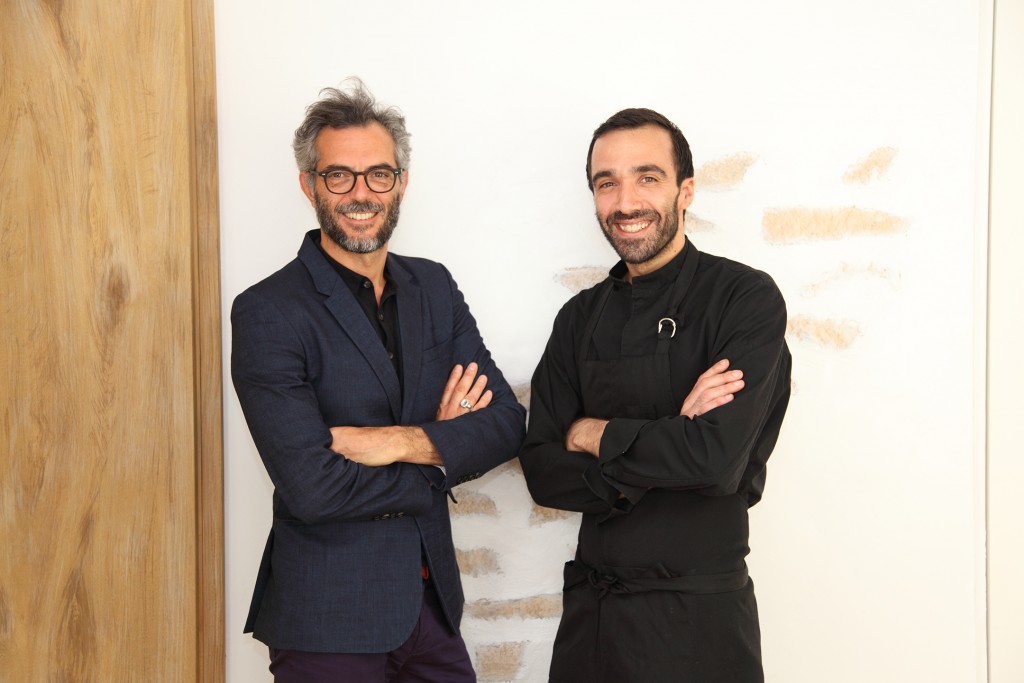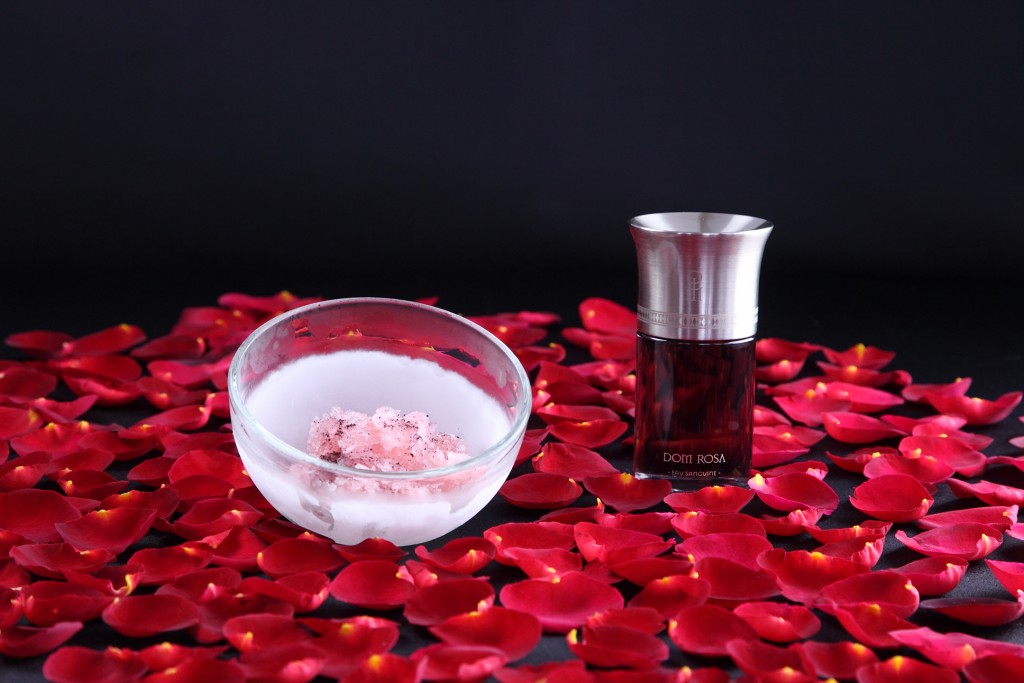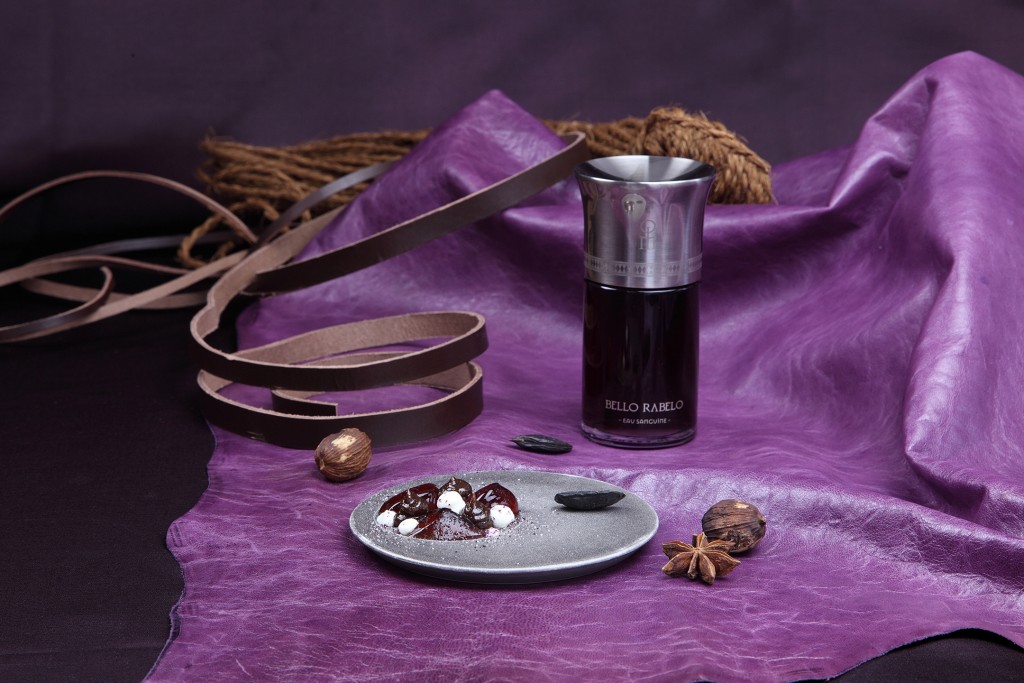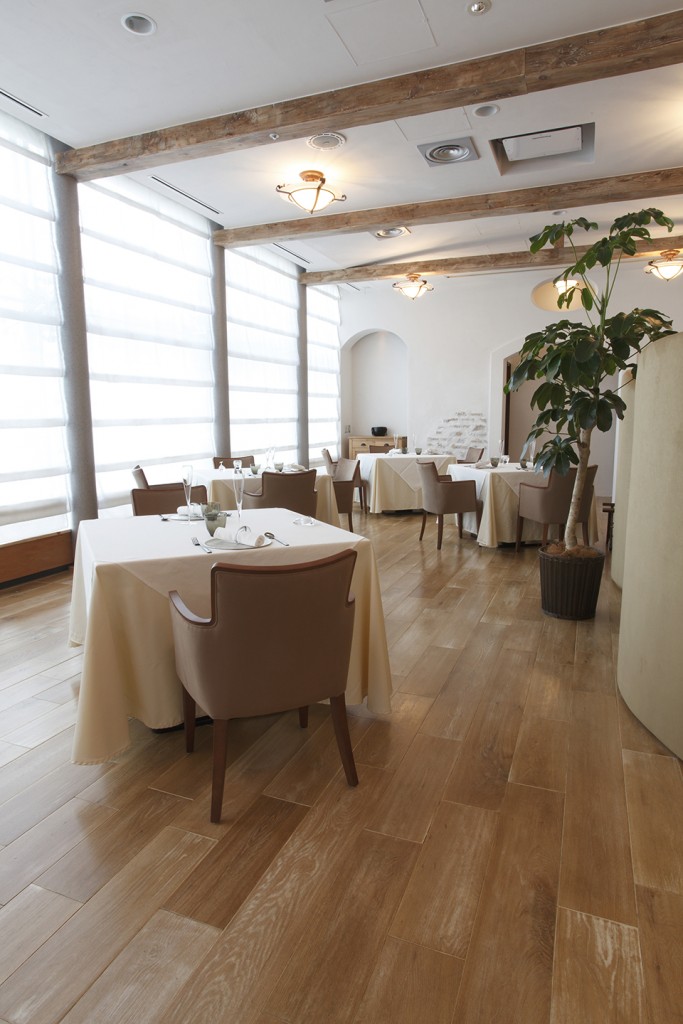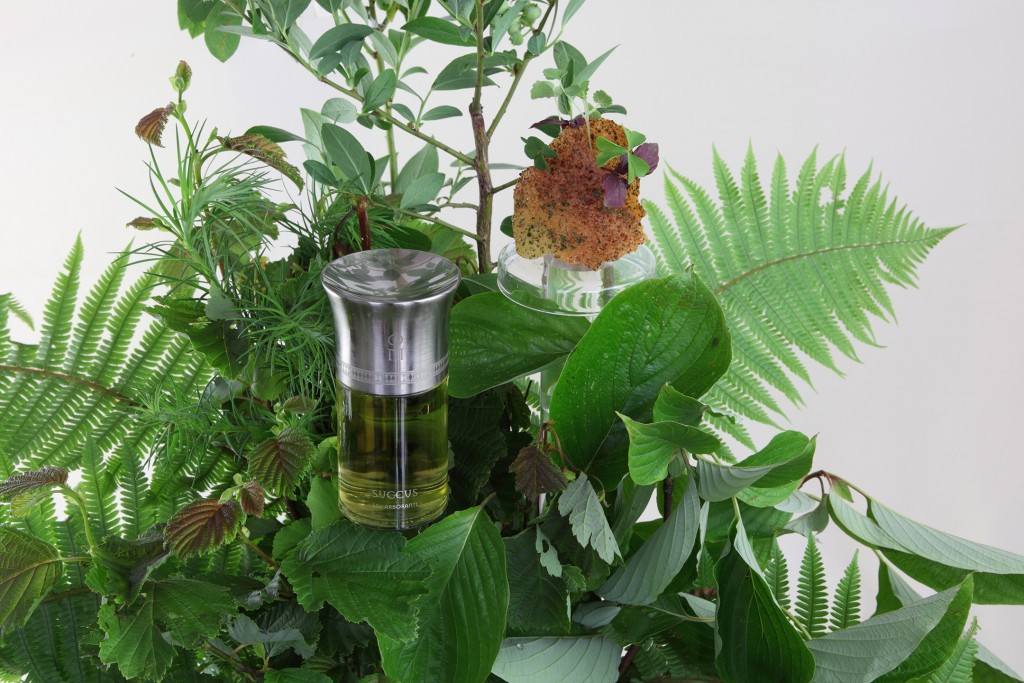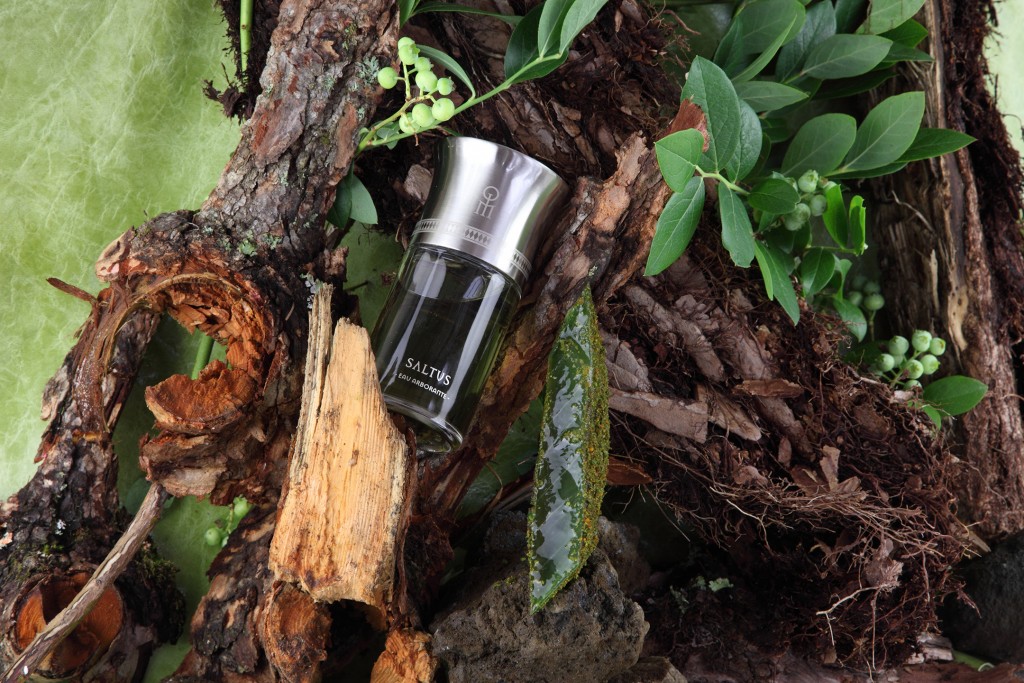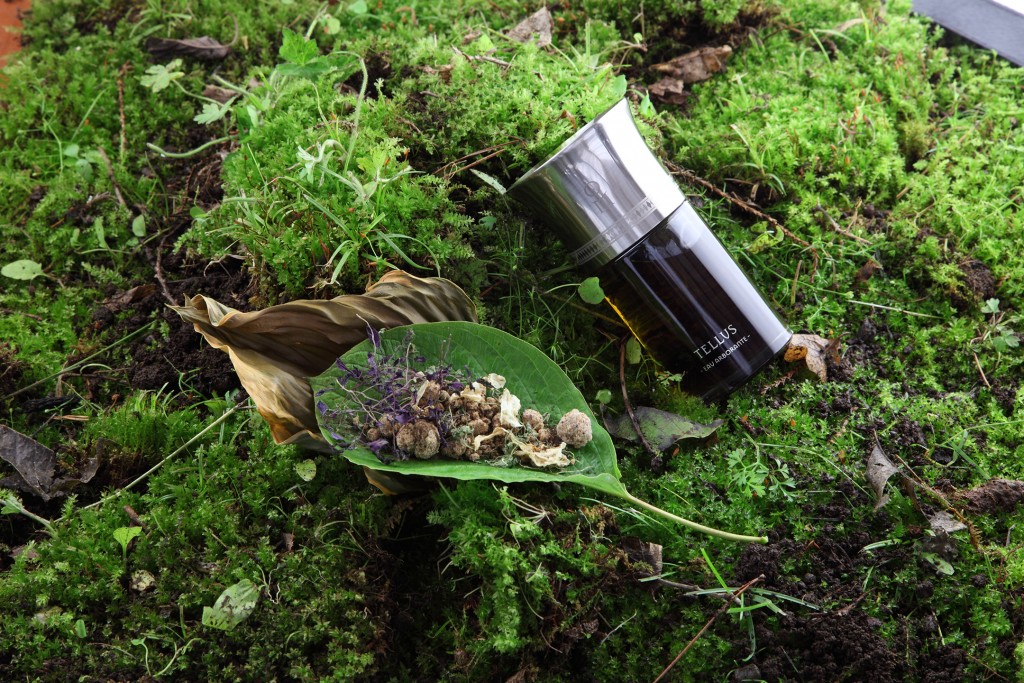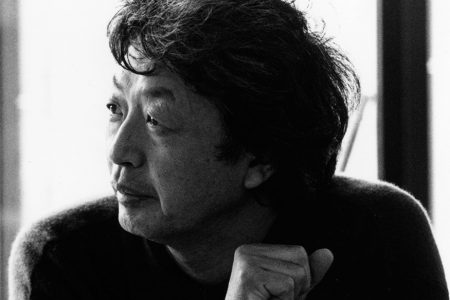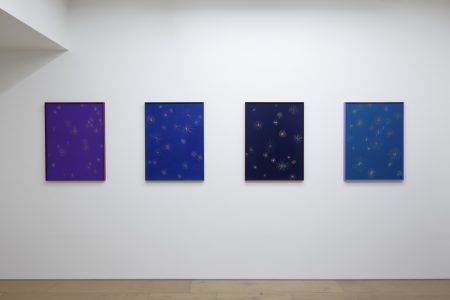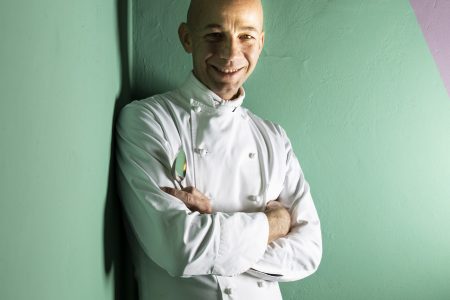Lionel Beccat and Philippe Di Méo: Perfume In a Culinary Form
In an interview, Michelin-star chef Lionel Beccat and perfumer Philippe Di Méo share their fascination for creating food touches based on fine fragrances.
Crossing the Pacific Ocean, fragrances unroll across the country of the rising sun. They awaken in an appeal to the senses, the beauty of a gesture and collusion. Seated at the Michelin-starred restaurant l’Esquisse in Tokyo, Japan, chef Lionel Beccat and perfumer Philippe Di Méo of perfume house Liquides Imaginaires reveal the secrets of their shared exploration into taste and scent.
The collaboration of the chef and the perfumer transformed two Liquid Imaginaires fragrance trilogies, Les Eaux Sanguines and Les Eaux Arborantes, into edible experiences and small food touches that bring together olfactory and taste with history, symbolism and hidden intentions of the perfumes. Originally served for an exclusive audience of twelve people, Beccat and De Méo talk about creating and merging the perfumes into food touches and the change of bringing the experience from Tokyo to Paris.
TLmagazine: Your artisanal and sensory approach is unusual. Where did this desire to collaborate on l’Esquisse and Liquides Imaginaires come from? Was it a search for excellence, immateriality, aesthetics?
Lionel Beccat: Since my friend Philippe Di Méo became a perfumer, we haven’t had the opportunity to create in shared universe, which we were able do several times during the time Di Méo was a designer. There was a desire to feel once again that alchemy, pleasure, sensory and creative stimulation that had led to our earlier adventures. The search for excellence is, of course, essential in my field, but never guides my way. It is not the transmitter and rather the receiver who appreciates through the distorting prism of his individuality, the value and aesthetic of things. A quest for immateriality, yes, always, to use our knowledge, our techniques and our intuition as combustibles to rise up into the weightlessness, becomes clear and murky.
Philippe Di Méo: From our first gustatory collaborations, our creative complicity was self-evident. We were on the same playing field. Lionel is a feline in his approach; he turns around the set target, sniffs all the sides before attacking the nub of the issue, and the result is devastating, strategic, decisive, precise; all in the beauty of movement.
This ritual evokes the wabi-sabi materiality described by Leonard Koren in his ‘Wabi Sabi: Further Thoughts’ book. Did your process follow a very conceptual and technical course, or was it rather spontaneous and intuitive?
LB: Each and every one of these four terms is inseparable within the creative process, even if I don’t really like the work ‘conceptual.’ We first imagined how to work on the retro-olfactory chemical mechanism based on Philippe’s fragrance trilogies, constructed the imaginary spheres where the taste multiplied and re-seeded the scent. Then we let the intuitive and spontaneous speak. The exercise excited me so much that I was literally raging, and my technique, that wise ally, had to bring it all to fruition.
PDM: To add to what Lionel said, our initial approach was not at all conceptual, because both of us go by our intuition. We don’t integrate this desire to conceptualise upstream, but as our creative elaboration passes through narrative, literary and even spiritual stages, corresponding with the most primitive emotions, the final result can resemble a concept, especially associated with the nose – palate tasting.
How did you develop your recipes based on Liquides Imaginaires fragrances? Can you briefly describe your two-month-long co-creative process?
LB: For a chef to work with a perfumer is perhaps the most lop-sided challenge he could endeavour, full of innumerable traps, inevitable mistakes, and complicated balancing acts. That being said, I threw myself into the battle, sword at the ready, with the arrogant certitude of one who knows that the outcome of the encounter cannot be in doubt. Obviously, I had a plan and an infallible weapon. The plan was the following: to entirely rethink my approach to odours. In the kitchen, scents and odours are indicating signals; they are olfactory points of reference in the culinary transformation process at work. Smelling is an instinctive gesture for us, but also a gesture of collection and analysis. The key to the combat was to accept a complete change of assumptions, to see odours not as a cardinal point, but rather as a focal point, to chase them rather than follow them.
And to do this, I had a powerful weapon, the attraction that the Liquides Imaginaires has on me. I have worn them all, I have a carnal relationship with them, from the road I have travelled with them, and hunting is simpler when you know the prey you are pursuing. Finally, throughout my efforts, I divulged to Philippe working angles and ideas; he gave me his feedback, new paths to follow, advice.
PDM: What was enriching for me was that Lionel didn’t fall in the trap of creating a dish to be enjoyed together with my perfumes. That is an exercise too often done. He invented materials, his recipes were textures, new flavours composed in reference to perfumes. To be discovered, the same sensations but on the palate. The result for the Eaux Arborantes was spectacular in its confusions; its preparation was camouflaged in a ‘mini wilderness’ on the table, as if created by some insects in the natural world. Perfect biomimicry.
In this game of corresponding tastes and scents, what was the ritual put in place? Did it fit in with Japanese culture?
LB: In one sense, yes. The Japanese invented the kōdō ceremony, which is the Japanese art of appreciating perfumes. It is one of the three traditional arts, along with the tea ceremony and ikebana floral arrangements. During a kōdō ceremony, the participants ‘listen to’ the fragrances released by burning incense, and they must, using the appropriate figures of speech for the Japanese language, express what this perfume evokes for them. Through this, the other participants must perceive whether the person has correctly identified the fragrance. This inspired our own game, with Philippe as the master of ceremonies. He first diffused each perfume on a pretty piece of paper on which I made a calligraphy design inspired by the fragrance, then the participants lifted it to their noses, while listening to Philippe’s explanations, creating a little set scene that offered a new olfactory dimension.
PDM: This is where the culture of Japanese ritual or ceremonial fascinates us, because there is total respect for that instant when the moment is sacred. No one speaks, there is no impatience and there is an attention that is both religious and amused during the experience offered. And in the end, everything seemed clear to them in the correspondences between scents and flavours.
Has this simultaneously intellectual, culinary and olfactory concept left any traces on the l’Esquisse menu?
LB: Of course, working on this project has turned my relationship with the olfactory completely on its head, especially with the arboreal trilogy. The work Philippe has carried out on these three perfumes is inspiring because it is a chef’s approach; the materials he used and the journey he took to reach his end have re-sparked my imagination.
How would you define the difference or the comparison between the Eaux Sanguines and Eaux Arborantes of Liquides Imaginaires and the recipes that came out of this alchemy with culinary ingredients?
LB: We chose the two trilogies that offered more space, real and imagined, to associate with food. The trilogy of Eaux-Delà was too sensual, too disturbing; it would not allow itself to be trifled with, and I could not managed to tame it. The two beautiful trilogies that I chose play on a distinctive register that allowed me to build two unique universes. Eaux Sanguines are perfumes with projecting angles, and marked contrasts. Acid, bitter, fruity, floral, spicy; they are frontal perfumes. Philippe has created a trilogy that is both lyrical and romantic, but also violent and venomous. I wanted to extend this duality with opposing flavours, textures and temperatures to impact on their nature. The Eaux Arborantes, for their part, are true gems of mimicry. Philippe has imagined a symbolic significance for each of them. Whether it’s land for perfume Tellus, sap for fragrance Saltus for sap or treetop for perfume Succus, his olfactory work impressed me. That’s why I stayed so close to this mimicry; I extended it, and pushed it to its climax.
How has the Japanese press responded to the food-fragrance experience that took place at l’Esquisse. Would you like to revisit it in Paris for a Western audience?
LB: The 12 journalists present experienced a unique moment; they really didn’t know what to expect when they came, and they were all affected, some more we had imagined. We received some very sensitive testimonials and offers to recreate the event for a larger audience.
We are thinking about how we could redo this in Paris; personally I would like to try a complete dinner. It’s in the pipeline, we have more than one trick up our sleeves.
PDM: In essence, we invited them to participate, to share an experience. Neither Lionel nor I needed to prove or promote our work, especially as my perfumes were not yet being distributed in Japan. It gave the press another image of fragrance, more intense, closer to the sacred universe of incense and its religious ritual, except that in our case the approach was totally modern, innovative and very intimate. •
The interview was originally published in TLmag 24, From East Asia to Northern Europe in December 2015.
Main image
EAUX SANGUINES: BLOODY WOOD
A silent duel of love that releases its truth in its ‘juice’. The chilly and metallic notes of a bloodied cold weapon in contrast with red cherry and raspberry juices on a background of oak barrel.
INGREDIENTS – Rhubarb, tarragon, ginger and lemon balm jelly Macerated juice of raspberry, current, wild strawberry, sansho pepper. Sugar rubbed with wild kinome.
